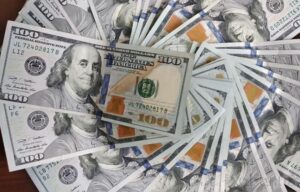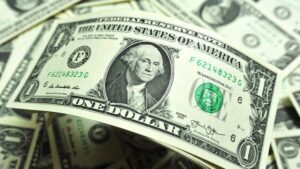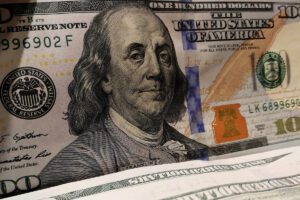
The US dollar rate was almost unchanged against the euro and the pound sterling on Friday morning, but demonstrated an active rise in pair with the yen on the results of the Bank of Japan meeting.
The ICE-calculated index showing the U.S. dollar’s performance against six currencies (euro, Swiss franc, yen, Canadian dollar, pound sterling and Swedish krona) was down less than 0.1% during this morning’s session. The broader WSJ Dollar Index was up less than 0.1%.
The euro/dollar pair is trading at $1.0589 as of 8:00 a.m., versus $1.0585 at the close of Thursday’s session.
The pound sterling is trading at $1.1925 versus $1.1924 at the close of last session.
Foreign exchange market participants took a wait-and-see attitude ahead of Friday’s publication of statistical data on the U.S. labor market.
The Labor Department report will be released at 3:30 p.m. and analysts polled by Trading Economics expect it to show the unemployment rate will remain at 3.4 percent and the number of jobs in the U.S. economy will climb by 205,000.
Strong labor market data could be an important argument for the Fed to raise interest rates by 50 basis points at the March meeting. The market generally expects just such a scenario, although last week’s consensus forecasts called for a hike of just 25 bps.
Meanwhile, the dollar-yen exchange rate rose 0.4% to 136.65 yen against 136.14 yen the day before.
On Friday, the Bank of Japan expectedly didn’t change the main parameters of the monetary policy on the results of the meeting, which was the last for the head of the central bank Haruhiko Kuroda who heads the bank since 2013.
Japan’s parliament this week approved Kazuo Ueda as the next head of the central bank. He will lead the Bank of Japan on April 8, when Kuroda’s term expires. The next meeting will be held under his leadership on April 27-28.

The U.S. dollar is stable against the euro and the yen in trading on Tuesday and is weak against the pound.
The market is waiting for Federal Reserve (Fed) Chairman Jerome Powell’s semiannual report on monetary policy, which he will deliver before the Senate Banking Committee and the U.S. House Financial Services Committee on Tuesday and Wednesday, respectively.
Also this Friday, the U.S. unemployment figures for February will be released.
Powell is unlikely to say anything definitive about the further pace of the prime rate hike, since the key data that will affect the Fed’s decisions during the March meeting will be released after his remarks.
“The Fed wants to see more statistical data before it makes its next moves,” notes MacroPolicy Perspectives Chief Economist Laura Rosner-Whorbaton, quoted by Market Watch.
“Powell is likely to emphasize that the Fed still has a lot of work to do to fight inflation,” she says. – The Fed’s work is not over, and the central bank will continue to do it until it does it completely.”
The ICE-calculated index showing the dollar’s performance against six currencies (euro, Swiss franc, yen, Canadian dollar, pound sterling and Swedish krona) is losing 0.11% in trading, while the broader WSJ Dollar Index is adding 0.02%.
The euro/dollar pair is trading at $1.0685 as of 8:15 a.m., up from $1.0686 at Monday’s market close.
The pound/dollar exchange rate rose to $1.2040 from $1.2028 at the close of the previous session.
The U.S. currency pair with the yen rose to 135.94 yen from 135.92 yen the day before.
The rate of Australian dollar weakened to $0.6704 from $0.6730 at the close of previous trading session.
The Reserve Bank of Australia (RBA) on Tuesday raised its key interest rate by 25 basis points (bps) to 3.6% a year. This is the tenth increase in the cost of credit since last May, the rate was raised by 350 bps in total and is at its highest since May 2012.
Statement of the Australian Central Bank, however, was less “hawkish” than in the past, notes Market Watch. RBA stated that inflation in the country, probably, has already reached its peak level, and further decisions on tightening of monetary policy will depend on statistical data.

The U.S. dollar is strengthening against the euro, the yen and the pound sterling in trading on Tuesday amid market revisions of expectations for the Federal Reserve (Fed) rate peak.
The ICE-calculated index showing the dollar’s performance against six currencies (euro, Swiss franc, yen, Canadian dollar, pound sterling and Swedish krona) added 0.17% in trading, while the broader WSJ Dollar Index gained 0.16%.
The euro/dollar pair is trading at $1.0585 as of 8:15 a.m., up from $1.0611 at Monday’s market close.
The pound exchange rate had dropped to $1.2041 by that time from $1.2065 the day before.
The value of the American currency against the yen is 136.31 yen against 136.23 yen at the end of the previous session.
The futures market expects the Fed’s rate to peak at 5.4% this year, although a month ago the maximum rate was estimated at 5%, Bloomberg noted.
The adjustment of traders’ expectations is related to signals of the sustainability of inflation in the U.S. According to the data published on Friday, the consumer price index (PCE index) in the states in January increased by 0.6% against the previous month (the maximum increase for six months), and in annual terms it rose by 5.4%. The rate of growth accelerated compared to December, when it was 0.2% and 5.3%, respectively.
Statistical data from the euro zone, to be released Thursday, are expected to show some easing of inflation in the region in February. The consensus analyst forecast cited by Trading Economics expects the euro area’s consumer price growth rate to slow to 8.2% on an annualized basis this month from 8.6% in January.
However, the rate of consumer price growth excluding food and energy (CPI Core, a core inflation indicator) is expected to remain at 5.3%, a record high.
The swap market expects the ECB deposit rate, currently at 2.5%, to rise to 3.9% in February 2024.

The ICE-calculated index showing the dollar’s dynamics against six currencies (euro, Swiss franc, yen, Canadian dollar, pound and Swedish krone) is losing 0.03% in trading, while the broader WSJ Dollar Index is stable.
The minutes of Wednesday’s Jan. 31-Feb. 1 U.S. Central Bank meeting showed that Fed policymakers plan to continue raising rates, believing that current levels are not enough to curb economic activity to beat inflation. At the same time, they believe that the cycle of rate hikes could be completed this year.
According to the minutes, meeting participants also noted that the restrictive policy will need to be maintained until the Central Bank has “confidence that inflation is on the path to a steady decline to the 2% level.”
Eurozone inflation stats released Thursday confirmed investors’ view that the European Central Bank will continue to tighten policy sharply.
According to final data from the European Union Statistical Office (Eurostat), consumer prices excluding food and energy (CPI Core Index, an indicator of core inflation) rose at a record annual rate of 5.3% in January. They had been previously reported to have risen 5.2% in January, and analysts did not expect the data to be revised.
The estimate for consumer price growth as a whole was revised to 8.6% annualized from the previously announced 8.5%, Eurostat said.
The euro/dollar pair was trading at $1.0603 as of 8:15 a.m., up from $1.0596 at market close on Thursday.
The pound is at $1.2023 from $1.2013 the day before.
The U.S. currency fell to 134.58 yen against 134.68 yen in trading during the previous session.
Kazuo Ueda, who was nominated as the head of the central bank by the Japanese government said during his speech in the parliament on Friday that he considered it reasonable to keep ultra soft monetary policy in Japan in order to achieve the central bank’s inflation target. At the same time, he made it clear that he sees various options for controlling the yield curve of government bonds in the future.

The world’s largest cryptocurrency exchange, Binance, is imposing a ban on dollar deposits and withdrawals, the company said in a statement, without specifying the reasons for the decision.
“We are temporarily suspending bank transfers in dollars as of Feb. 8,” said a Binance spokesman quoted by CNBC.
He added, however, that the company is working to resume these transactions as soon as possible.
Binance US, which is regulated by the U.S. Treasury’s Financial Crimes Enforcement Network (FinCEN), said in a statement posted on Twitter that the decision to suspend operations has not affected it. Thus, it only affects users outside the U.S. who transfer dollars to or withdraw dollars from bank accounts.
Binance’s announcement triggered a surge in cash outflows from the exchange’s cryptocurrency wallets, according to Arkham Intelligence.
Net cash outflows from the exchange exceeded $172 million in one day, according to DefiLlama. By comparison, the company has $42.2 billion in cryptocurrency assets, so the outflow is negligible, Arkham noted.

The ICE computed index showing the dollar’s trend against six currencies (euro, Swiss franc, yen, Canadian dollar, pound and Swedish krona) gained 0.15%, while the broader WSJ Dollar Index gained 0.09%.
The ICE dollar index jumped more than 1 percent Friday following the release of U.S. economic data showing that the U.S. labor market remains strong, leaving ample room for the Federal Reserve (Fed) to maneuver further tightening monetary policy.
According to the U.S. Labor Department, the number of jobs in the U.S. economy increased by 517,000 in January and unemployment fell to its lowest level since 1969, 3.4%.
This week, traders will be waiting for more signals from Federal Reserve (Fed) Chairman Jerome Powell, who will speak at the Economic Club in Washington on Tuesday.
During a press conference on the results of the January 31-February 1 meeting of the U.S. Central Bank, Powell acknowledged for the first time that “the disinflationary process has begun. He also suggested that the Fed rate, which was raised to 4.5-4.75% at the end of the meeting, would not exceed 5%, and reiterated that the Fed could achieve slowdown in inflation without causing significant harm to the economy.
The euro/dollar pair is trading at $1.0797 as of 7:55 a.m., up from $1.0799 at the close of the previous session.
The pound is at $1.2062, compared to $1.2056 at the close of the previous session.
The dollar rose to 131.71 yen against 131.18 yen the day before.